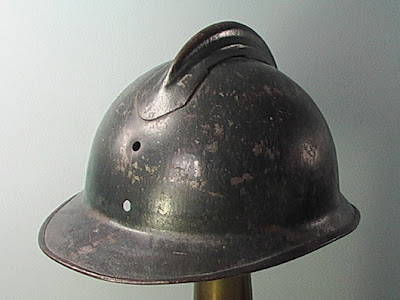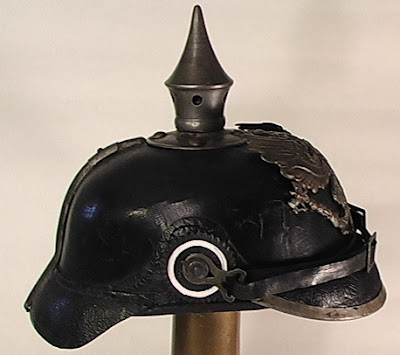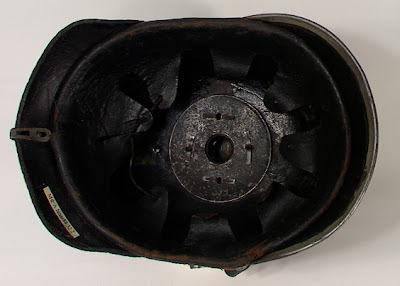 (with regimental crest)
(with regimental crest)An outright copy of the French "Adrian" helmet, this attractive Italian manufactured gem, known as the "Lippmann helmet", simplified the construction process and eliminated many of the weaknesses of it's French progenitor. The Italian soldier of 1915 - 1916 had the next step in state-of-the-art helmet design.
 This soldier wants YOU to appreciate his revolutionary helmet.
This soldier wants YOU to appreciate his revolutionary helmet. The Italian soldier, like his French and British counterparts, entered the war with the cloth caps of an earlier era... not so hot in protecting the head from high-velocity artillery shell fragments.
The Italian soldier, like his French and British counterparts, entered the war with the cloth caps of an earlier era... not so hot in protecting the head from high-velocity artillery shell fragments.This elegant improvement of the French Adrian design included a two-piece construction rather than the four-pieces of its French counterpart. Fewer pieces meant fewer points of failure when impacted by debris, fragments, or shrapnel.
 Another improvement to the integrity of this helmet was the elimination of rivets. The French Adrian helmet was riveted together, each rivet providing a weak point. Note that the ventilator crest of this little Italian job is spot-welded, all rivets are eliminated on this helmet, giving it improved structural integrity over its French forebear.
Another improvement to the integrity of this helmet was the elimination of rivets. The French Adrian helmet was riveted together, each rivet providing a weak point. Note that the ventilator crest of this little Italian job is spot-welded, all rivets are eliminated on this helmet, giving it improved structural integrity over its French forebear.Oddly, rivets will reappear in the next generation of WW1 Italian helmets (the subject of my next posting).

Here, sadly, and graphically, we are reminded that no helmet of World War One was bulletproof. This specimen was pierced, at the temple, by a high-velocity bullet; mute testimony to the vulnerability of the front-line soldier to the marksmanship of his enemy.
 The interior view reveals an opening in the crown connecting the ventilation holes of the crest to the head of the wearer.
The interior view reveals an opening in the crown connecting the ventilation holes of the crest to the head of the wearer.I acquired this helmet without a liner. Or the Grenadiers crest. Normally I would pass on a helmet with no liner or chinstrap, however, the condition of the shell and the telling bullet hole made this a particularly compelling piece for my collection. With the recent addition of the 3rd Grenadiers insignia, its become a centerpiece!

 This elegant little gem in its very modest way has become a real stand-out in my collection.
This elegant little gem in its very modest way has become a real stand-out in my collection.And a word on my accession number system. I've had readers question how I catalogue the helmets in my collection. I use two primary sources for my nomenclature: Chris Armolds "Steel Pots" volumes and the aforementioned volumes by Paolo Marzetti (Combat Helmets of the World).
Specifically this example guides off the Marzetti book: MOA (Museum of America) h (helmet) mar (Marzetti) 151 (page 151)
43.28 (figure 43.28). Simple huh?

provenance:
accession number: MOA hmar.151.43.28
Model 1915/16 Italian helmet.
Acquired 1978, Lansing Michigan.
Purchase price :$5.00
Condition: shell only, original paint 80%
Next post: The Italian model 1915 riveted crest helmet of World War One


























